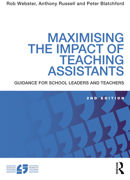Inspiration SEND Network Book Blog #2: Maximising the Impact of TAs
Back
Maximising the Impact of Teaching Assistants: Guidance for school leaders and teachers (2nd Ed.)
Rob Webster, Anthony Russell and Peter Blatchford
Sarah Pardon, SENCO at Cromer Academy, shares her reflections on the powerful thinking that this book has brought to her practice.
 Every good book contains that one line that hooks the reader early on. For me, this line appeared at the bottom of page 2:
Every good book contains that one line that hooks the reader early on. For me, this line appeared at the bottom of page 2:
‘…we conclude that a fundamental rethink is required in the way TAs are used in order to avoid letting down supported pupils.’
This line echoed in my head as I read the rest of the book, and with every piece of research, case study or scenario discussed I found myself asking: How does this compare to what's happening in my setting?
The authors have dedicated the entire first chapter to providing the reader with an overview as to how Teaching Assistant (TA) deployment has evolved over the past two decades. They continually refer to the Deployment and Impact of Support Staff (DISS) project, the Effective Deployment of Teaching Assistants (EDTA) project and the Maximising the Impact of Teaching Assistants (MITA) programme. All of these have a common goal – to explore how TAs are deployed with a view to maximising the impact of TAs. They stress that the annual cost of one TA often exceeds that of many other provisions and that ineffective deployment can often cause more harm than good, which is why it is key for school leaders to keep TA deployment under review.
By the time I had reached the end of the first chapter I had considered where it might be possible to develop the TA deployment within my own setting. Having done this, I found myself naturally formulating a plan of action as I read through chapter 2. Chapter 2 contains all the information leaders need to conduct an in-depth audit into how TAs are deployed. The tools provided are simple to use and many of them are available to download from here. By the end of the chapter, I had decided which tools would be most appropriate and had formulated a plan for auditing practice within my own setting.
I found the tools in the book, and online, were very user friendly. These tools have been designed with careful consideration of workload and purpose. The authors also provide a narrative for the reader to support with the use of the tools that they recommend. In each of the narratives they provide do’s and don’ts, which include how to approach the audit with sensitivity so that everyone involved views this as a developmental supportive process. I have read many books around school development and SEND, and this is the first I have come across that actually provides a complete breakdown of how to lead and manage development of TA deployment – it is literally a step by step guide for leaders. Not only does it walk the reader through the processes, it also provides guidance on how to ensure that staff involved feel supported and considered throughout.
The book’s title suggests that it is not just for school leaders, but also for teachers. While there is a lot of key information that all teaching staff and leaders would find useful, the chapter that I believe is really targeted at teachers is chapter 4. This chapter discusses how teachers can reflect on the findings of the audit to develop best practice within their own classrooms. However, the authors later state that for TA deployment to be effective, it needs to be a whole school strategy. There is an implication that it is important to first focus on implementing a whole school strategy prior to the classroom teachers fine tuning their own practices.
There is an underlying theme that implies that the classroom deployment of TAs must be driven by the leadership team through the development of a policy and clear guidelines around how TAs should be deployed across the school. The authors explain the importance of considering pupil needs and tailoring guidelines and policies specifically to the school. As with all good books focused on developing provision for pupils with SEND, this book encourages leaders and teachers to take a pupil-centred approach in line with the SEND Code of Practice.
It is important that staff feel empowered and able to perform well in their role. The authors refer to this element of the TA role as ‘preparedness’. In addition to ensuring TAs are adequately trained, school leaders need to ensure that TAs have allocated time to liaise with teaching staff. The authors acknowledge that this is often easier in primary settings compared with secondary, but regardless of how this is achieved, the authors stress that improving the preparedness of TAs ultimately increases the impact they have within a lesson.
If, like me, you are a naturally reflective person, you will find that this book will take you on a journey that challenges your thinking every step of the way, and you will naturally find yourself considering how TA deployment could be improved within your own setting. The authors acknowledge that there is not a model of TA deployment that fits all settings. Instead, they imply that leaders must consider how TAs are deployed and how this could be developed to ensure the best possible outcomes for the pupils in their own specific environments. The evidence presented early in the book, I believe, provides a compelling argument as to why school leaders must make this a developmental focus and I would therefore recommend this book to anyone who has responsibility for leading on the development of provision.
Like what you’ve read? Want to find out more? Head to Twitter or check out the EEF guide to effective deployment of TAs.
